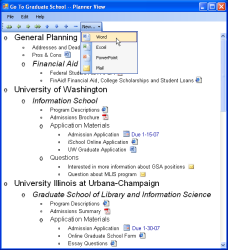Qualities: Intellectual Works
Much of my work at the iSchool has contributed to my intellectual growth. I have learned through all the projects mentioned in the other sections, and especially from my activities surrounding the TiddlyWiki Thesaurus. In addition, the research and discussions that took place in my courses were significant in changing how I think about the world, and what I think about. However, I have chosen two projects below to discuss in more detail.
FlipSwitch Prototype

FlipSwitch prototype results
The INFO 498: Input and Interaction course that I attended in Spring 2008 offered many challenges. It is the only HCI course I have taken, and it often took a very low level approach at how humans use computer interfaces. We explored design methodology and encountered a wealth of academic articles and demonstrations of research prototypes. The final group project in the course asked us to design and build an interaction prototype based on some criteria.
My main contribution to our final group project was in the creation of the prototype itself. My group members focused on the initial design idea and the report and presentation, although I aided in those efforts as well. We were permitted to use whatever technology we chose for the prototype. I decided to create a pure HTML and JavaScript prototype in an effort to make it compatible with most browsers and operating systems. I was also anxious to try out Walter Zorn's High Performance JavaScript Vector Graphics Library which I had discovered while doing research in LIS 545. In addition to teaching myself how to use Zorn's library, I also had to devise a method to animate and display the interface components required by our chosen design. This was not trivial, and I redesigned and optimized the code several times before producing the final version. While the main goal of the project was to have a working prototype, I also focused on usability issues as I identified them. Ultimately, the prototype became not only a working example of the interaction technique, but was a fully functional platform that could capture data from experimental trials and visualize the results. You may want to get more information about the project or try out the actual prototype.
Keeping Found Things Found

The Project Planner prototype
As a member of the KFTF team during my first year in the MLIS program, I had the opportunity to work alongside researchers in the personal information management field. I was presented with new topics and ideas to explore, and I was given some ownership in the creation of the Project Planner prototype. The development work for the prototype was to be done in C#, and I had no previous experience with this language. It was challenging to learn new concepts and a new programming language all while taking full course loads. I had the opportunity to listen to presentations given by Microsoft Research personnel, and also gave several presentations of my own covering the Project Planner, it's status, and future directions. (Presentation files are available here: ![]() 12-13-06,
12-13-06, ![]() 1-24-07,
1-24-07, ![]() 2-21-07)
2-21-07)
A joint paper was published on the Planner, entitled The personal project planner: planning to organize personal information. For my editing efforts and suggestions I was given an acknowledgement in William Jones' book titled Keeping Found Things Found.